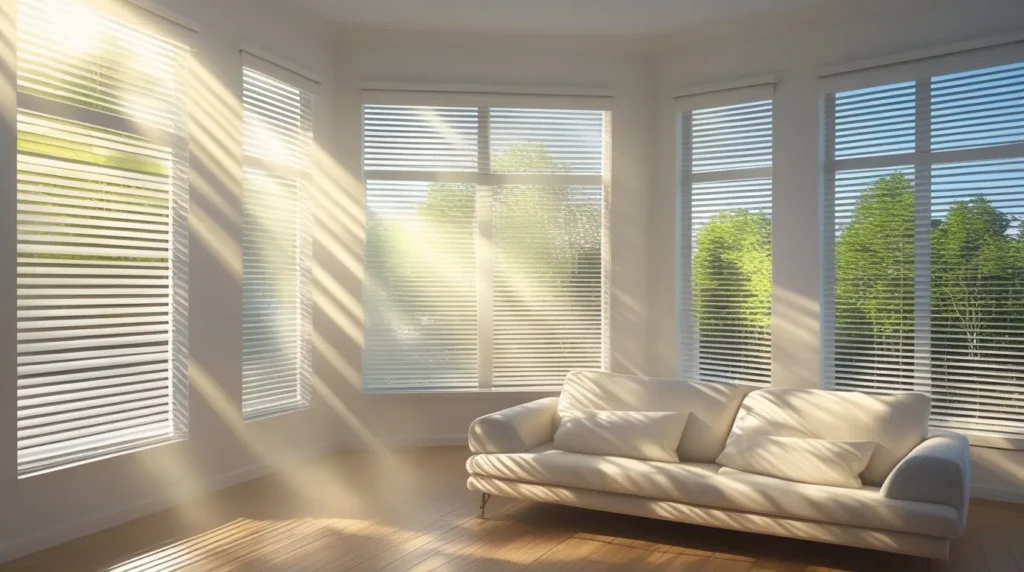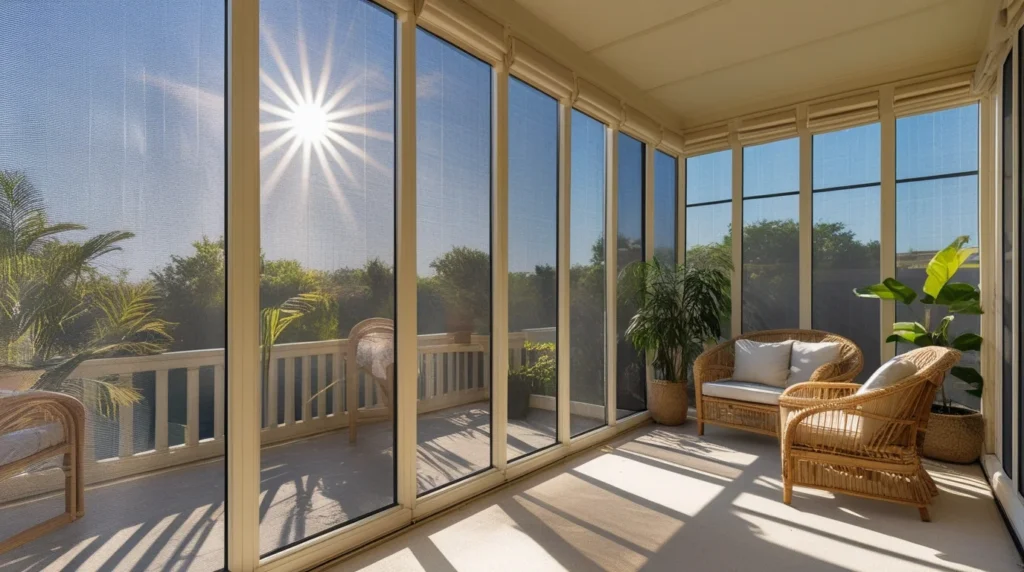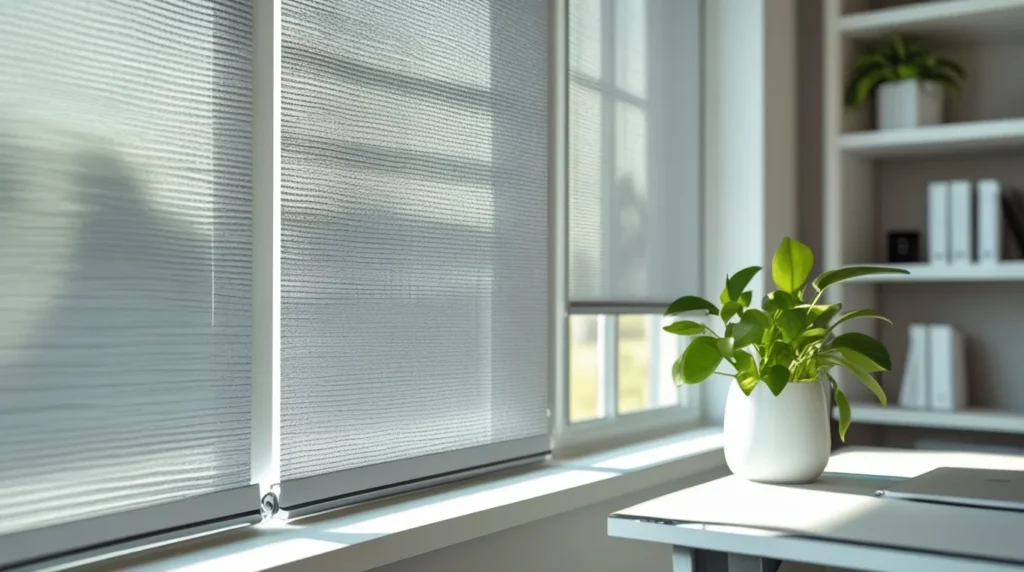Why UV Rays Matter: Protecting Your Home
UV rays from ultraviolet A (UVA) and ultraviolet B (UVB) light—are invisible parts of the sun’s energy. While full sunlight brightens and warms our rooms, these UV rays can cause serious damage to home interiors. When UV light streams through windows, it can fade fabrics, weaken wood fibers, and age decorative surfaces. In Southern California’s strong, year-round sunshine, these effects happen even faster: painted walls lose their vivid tones, rugs and upholstery turn dull, and hardwood flooring can crack or warp over time.
Protecting your living space from UV rays not only extends the life of your furnishings; it also keeps rooms cooler, reducing air-conditioning costs. Studies show that up to 40% of a home’s heat gain comes from solar radiation. Effective sun blocking can lower energy bills and keep indoor temperatures more comfortable without overworking HVAC systems. Understanding if and how your window coverings block UV light can help you choose the right solution and safeguard your investment in furnishings and energy savings.
How Sunlight and UV Light Affect Interiors

Natural sunlight brings health benefits and a pleasant glow to living spaces. However, it carries high-energy UV wavelengths that can penetrate glass and damage materials. UVA rays penetrate deep into fabrics and plastics, altering chemical bonds and fading dyes. UVB rays, though less abundant, carry greater energy and can break down surface coatings, varnishes, and paints.
Imagine your favorite armchair near a sunny window. Day by day, the fabric’s vibrant color softens. After a year, the once-bright pattern looks washed out. Similarly, wood furniture or flooring near windows can dry out and crack because UV rays break down the lignin that gives wood its strength and color. Even exterior materials suffer: car interiors parked in driveways can show faded dashboards and upholstery after months of exposure.
Sunlight also heats rooms. Glass windows let in infrared radiation, warming indoor air. When combined with UV damage, the effect is twofold: heat makes materials expand and contract, speeding wear, and UV light attacks chemical bonds. Curtains, drapes, and shades can intercept this radiation before it harms interiors.
Energy and Cost Savings with UV-Blocking Window Coverings
Installing blinds, shades, or screens that block UV rays not only protects interiors but also delivers real energy savings. By reducing solar heat gain, UV-blocking window treatments lower the work required by air-conditioning systems. Homeowners can see up to a 15% decrease in cooling costs during peak summer months. Over time, this reduction offsets the upfront cost of high-performance coverings. Additionally, many utility companies offer rebates for energy-efficient window solutions, making it even more affordable to upgrade.
Understanding What Blocks UV Light

Not all materials block UV rays equally. Glass blocks almost all UVB but lets through about 75–90% of UVA. Standard window glass, even double-pane, cannot fully stop UVA. To enhance protection, homeowners add barriers:
- Specialty Films: Thin, transparent laminates adhered to glass surface. They block up to 99% of UVA and UVB while preserving clarity.
- Solar-Blocking Fabric for Windows: Woven or coated textiles designed to reflect or absorb UV radiation. Many come with an aluminized backing or UV-resistant coatings.
- Sun Protection Screens: Installed outside or between panes, these mesh screens absorb UV light before it touches glass.
- Protective Window Coverings: Roller shades, honeycomb blinds, and drapes made with UV-blocking fibers or interwoven metallic threads.
Each option reduces UV transmission differently, so understanding their performance ratings (often given as UV protection percentage or UPF rating) is key. Look for products rated UPF 50+ for highest protection.
Do Blinds Block UV Rays? The Science Behind It
Blinds, with their adjustable slats, offer both shade and style. When closed, properly fitted blinds can block a significant portion of UV light. Here’s how:
- Slat Material: Wood, vinyl, aluminum, and fabric slats each have different UV absorption properties. Aluminum and vinyl slats with reflective coatings can send up to 90% of UV rays back outside. Wood slats naturally absorb some UV, reducing transmission.
- Slat Width and Fit: Wider slats overlap more when closed, leaving fewer gaps. Custom-fit blinds that snug against window frames minimize edge leakage.
- Surface Finish: High-gloss and reflective finishes outperform matte surfaces by reflecting UV and infrared light.
- Layering: Combining blinds with UV-blocking window film or blackout liners boosts protection, cutting UV transmission by 95–99%.
Testing laboratories measure UV transmission through blinds using spectrophotometers. Quality blinds often carry data sheets showing UV-blocking percentages. Homeowners should compare specifications: a standard vinyl blind might block 70–80% UVA, while a solar-coated aluminum blind can reach over 90%.
Top Blinds to Block Sunlight and UV Light Shades
When choosing blinds, consider both UV protection and daily use. Here are leading types:
- Solar-Blocking Blinds: Also called solar shades, they are made of a tightly woven screen that filters light and UV without darkening the room entirely. Sun-blocking shades often specify openness factors (e.g., 1%, 3%), where lower percentages block more UV and light.
- UV Light Shades: Roller shades with UV-absorbing films laminated into the fabric. They maintain view-through capability while filtering up to 98% of UV rays.
- Sunblock Shades: Heavy-duty, opaque roller or Roman shades. When pulled down, they completely seal off UV, light, and heat. Ideal for bedrooms or media rooms to create dark, cool environments.
- Aluminum Mini-Blinds with Reflective Coating: Standard 1″ or 2″ slats coated with reflective paint. Affordable and highly reflective, these block UV and lower heat gain.
- Wooden Blinds with UV Sealer: Natural wood slats treated with UV-resistant varnish. They combine warmth and style with moderate UV protection.
Consider style, light control needs, and budget. Gallery Shutters Inc. offers custom options for each type, complete with professional installation to ensure a tight fit.
Sun-Blocking Drapes, Screens, and Protective Window Coverings Compared
While blinds are versatile, other coverings excel in specific areas:
- Sun-Blocking Drapes: Heavy blackout or thermal drapes use dense fabric and often include insulating backings. They block up to 100% of UV and infrared, reduce noise, and add an extra layer of insulation. Drapes work best in rooms where total darkness is desired, like home theaters or bedrooms.
- Sun Protection Screen: These screens mount outside or between panes. Made from fiberglass or polyester mesh coated with PVC or aluminum, they stop UV before it hits the glass. Screens also reduce glare and heat, ideal for sunrooms, patios, and garages.
- Protective Window Coverings (Films/Laminates): Applied directly to glass, these nearly invisible films keep out up to 99% of UV and can also add shatter resistance. They work on any window type without bulky hardware.
Choosing UV Protection Screen and Solar-Blocking Shades for Southern California
Southern California’s sunshine demands strong, lasting UV defense. When your home’s west- and south-facing windows face the hottest afternoon rays, consider solar-blocking shades with a 1–3% openness factor. These fabrics filter most UV and glare while still letting in natural light. For expansive sliding doors or floor-to-ceiling panes, exterior sun protection screens absorb heat and UV before they reach your glass, cutting cooling load by up to 65%. Inside, sleek roller shades laminated with UV films offer protection without altering your exterior look—choose white or light gray materials to reflect light inward and keep rooms bright. If daytime privacy matters, opt for solar shades or UV light shades with tinted backings: they allow you to see out clearly while preventing outside views into your space.
Maintenance Tips to Keep Your Window Blinds Sun Protection

Its Best to Keep Your Window Blinds Sun Protection
- Clean Slats Regularly: Dust and wipe with a damp, mild-soap solution. Avoid harsh chemicals that can strip UV coatings.
- Inspect Screens: Check for holes, tears, or loose frames. Even small gaps let in UV and heat. Repair or replace damaged screens promptly.
- Re-treat Drapes and Fabrics: Some fabrics lose UV-blocking finishes over time. Use a UV-blocking spray treatment or reapply factory-approved coatings every 2–3 years.
- Check for Light Leaks: When blinds or shades are down, look for bright lines along edges. Side channels or blackout liners can close those gaps.
- Avoid Direct Water Exposure: Exterior sun protection screens should be rinsed gently with a garden hose, not pressure-washed. Direct sunlight and temperature swings can fade fabrics allow coverings to dry fully.
Regular maintenance keeps your UV-blocking solutions performing at peak levels. A yearly check-up and cleaning will preserve both function and appearance.
Conclusion
Protecting your home from UV rays preserves color, extends material life, and lowers cooling costs. From solar-blocking blinds and UV light shades to drapes and exterior screens, many solutions fit every style and budget. By choosing the right window coverings and maintaining them well, you can enjoy bright, comfortable spaces without worrying about damage. Gallery Shutters Inc. has the expertise to guide you in selecting the perfect UV-blocking products and ensuring a flawless installation.
Now is the time to shield your home from harmful rays. Contact Gallery Shutters Inc. today for a free consultation on the perfect blinds to protect your space and style.
